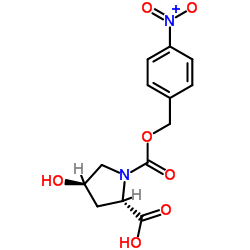96036-03-2
| Name | meropenem |
|---|---|
| Synonyms |
SM 7338
MEROPENEM, ANTIBIOTIC FOR CULTURE MEDIA USE ONLY (1'R,3'S,5'S,4R,5S,6S)-3-(5-DIMETHYLCARBAMOYL-PYRROLIDIN-3-YLSULFANYL)-6-(1-HYDROXY-ETHYL)-4-METHYL-7-OXO-1-AZA-BICYCLO[3.2.0]HEPT-2-ENE-2-CARBOXYLIC ACID [4R-[3(3S*,5S*),4a,5b,6b(R*)]]-3-[[5-[(Dimethylamino)carbonyl]-3-pyrrolidinyl]thio]-6-(1-hydroxyethyl)-4-methyl-7-oxo-1-azabicyclo[3.2.0]hept-2-ene-2-carboxylic Acid (1R,5S,6S)-2-[(3S,5S)-5-(Dimethylaminocarbonyl)pyrrolidin-3-ylthio]-6-[(R)-1-hydroxyethyl]-1-methylcarbapen-2-em-3-carboxylic Acid MEROPENEM (PATENTED) Merrem (4R,5S,6S)-3-{[(3S,5S)-5-(dimethylcarbamoyl)pyrrolidin-3-yl]sulfanyl}-6-[(1R)-1-hydroxyethyl]-4-methyl-7-oxo-1-azabicyclo[3.2.0]hept-2-ene-2-carboxylic acid MEROPENAM (4R-(3(S*,5S*),4-a,5b,6b(R*)))-3-((5-((Dimethylamino)carbonyl)-3-pyrrolidinyl)thio)-6-(1-hydroxyethyl)-4-methyl-7-oxo-1-azabicyclo[3.2.0]hept-2-ene-2-carboxylic acid MeropeneM API (4R,5S,6S)-3-{[(3S,5S)-5-(Dimethylcarbamoyl)-3-pyrrolidinyl]sulfanyl}-6-[(1R)-1-hydroxyethyl]-4-methyl-7-oxo-1-azabicyclo[3.2.0]hept-2-ene-2-carboxylic acid Meronem MEROPENEM,USP 1-Azabicyclo[3.2.0]hept-2-ene-2-carboxylic acid, 3-[[(3S,5S)-5-[(dimethylamino)carbonyl]-3-pyrrolidinyl]thio]-6-[(1R)-1-hydroxyethyl]-4-methyl-7-oxo-, (4R,5S,6S)- MEROPENEM FOR INJECTION (4R,5S,6S)-3-[[(3S,5S)-5-[(dimethylamino)carbonyl]-3-pyrrolidinyl]thio]-6-[(1R)-1-hydroxyethyl]-4-methyl-7-oxo-1-azabicycl 0[3.2.0]hept-2-ene-2-carboxylic acid MeropeneM Crude MEROPENEM, 1 G Meropen Meropenem 1-Azabicyclo(3.2.0)hept-2-ene-2-carboxylic acid, 3-(((3S,5S)-5-((dimethylamino)carbonyl)-3-pyrrolidinyl)thio)-6-((1R)-1-hydroxyethyl)-4-methyl-7-oxo-, (4R,5S,6S)- MFCD00864966 |
| Description | Meropenem is a carbapenem antibiotic, which displaying a broad spectrum of antibacterial activity.Target: AntibacterialMeropenem, a new parenteral carbapenem demonstrated increased activity as compared to imipenem against 336 strains of Neisseria gonorrhoeae, 119 strains of Haemophilus influenzae, and 110 strains of H. Ceftriaxone and ciprofloxacin demonstrated activity superior to that of both carbapenems while the activity of ceftazidime was similar to that of meropenem [1]. Meropenem, like imipenem and various experimental penems, may overcome the resistance problems presented by Class I beta-lactamases [2]. MEROPENEM was rapidly penetrated to the pleural effusion and was retained for a more prolonged time in the pleural effusion than in the blood of patients with accumulated pleural effusion, and it suggested the usefulness of MEROPENEM in antibacterial therapy for patients with pleurisy causing accumulation of pleural effusion [3].Clinical indications: Appendicitis; Bacterial infection; Bacterial meningitis; Bacterial pneumonia; Bacterial respiratory tract infection; Bacterial skin infection; Bacterial urinary tract infection; Bacteroides fragilis infection; Bacteroides infection; Bacteroides thetaiotaomicron infection; Complicated skin and skin structure infectionFDA Approved Date: July 1996Toxicity: In mice and rats, large intravenous doses of meropenem (2200-4000 mg/kg) have been associated with ataxia, dyspnea, convulsions, and mortalities. |
|---|---|
| Related Catalog | |
| References |
| Density | 1.4±0.1 g/cm3 |
|---|---|
| Boiling Point | 627.4±55.0 °C at 760 mmHg |
| Molecular Formula | C17H25N3O5S |
| Molecular Weight | 383.462 |
| Flash Point | 333.2±31.5 °C |
| Exact Mass | 383.151489 |
| PSA | 135.48000 |
| LogP | -3.13 |
| Vapour Pressure | 0.0±4.2 mmHg at 25°C |
| Index of Refraction | 1.639 |
|
Material Safety Data Sheet
Section1. Identification of the substance Product Name: Meropenem Synonyms: Section2. Hazards identification Harmful by inhalation, in contact with skin, and if swallowed. Section3. Composition/information on ingredients. Ingredient name:Meropenem CAS number:96036-03-2 Section4. First aid measures Skin contact:Immediately wash skin with copious amounts of water for at least 15 minutes while removing contaminated clothing and shoes. If irritation persists, seek medical attention. Eye contact:Immediately wash skin with copious amounts of water for at least 15 minutes. Assure adequate flushing of the eyes by separating the eyelids with fingers. If irritation persists, seek medical attention. Inhalation:Remove to fresh air. In severe cases or if symptoms persist, seek medical attention. Ingestion:Wash out mouth with copious amounts of water for at least 15 minutes. Seek medical attention. Section5. Fire fighting measures In the event of a fire involving this material, alone or in combination with other materials, use dry powder or carbon dioxide extinguishers. Protective clothing and self-contained breathing apparatus should be worn. Section6. Accidental release measures Personal precautions: Wear suitable personal protective equipment which performs satisfactorily and meets local/state/national standards. Respiratory precaution:Wear approved mask/respirator Hand precaution:Wear suitable gloves/gauntlets Skin protection:Wear suitable protective clothing Eye protection:Wear suitable eye protection Methods for cleaning up: Mix with sand or similar inert absorbent material, sweep up and keep in a tightly closed container for disposal. See section 12. Environmental precautions: Do not allow material to enter drains or water courses. Section7. Handling and storage Handling:This product should be handled only by, or under the close supervision of, those properly qualified in the handling and use of potentially hazardous chemicals, who should take into account the fire, health and chemical hazard data given on this sheet. Store in closed vessels, refrigerated. Storage: Section8. Exposure Controls / Personal protection Engineering Controls: Use only in a chemical fume hood. Personal protective equipment: Wear laboratory clothing, chemical-resistant gloves and safety goggles. General hydiene measures: Wash thoroughly after handling. Wash contaminated clothing before reuse. Section9. Physical and chemical properties Appearance:Not specified Boiling point:No data No data Melting point: Flash point:No data Density:No data Molecular formula:C17H25N3O5S Molecular weight:383.5 Section10. Stability and reactivity Conditions to avoid: Heat, flames and sparks. Materials to avoid: Oxidizing agents. Possible hazardous combustion products: Carbon monoxide, nitrogen oxides, sulfur oxides. Section11. Toxicological information No data. Section12. Ecological information No data. Section13. Disposal consideration Arrange disposal as special waste, by licensed disposal company, in consultation with local waste disposal authority, in accordance with national and regional regulations. Section14. Transportation information Non-harzardous for air and ground transportation. Section15. Regulatory information No chemicals in this material are subject to the reporting requirements of SARA Title III, Section 302, or have known CAS numbers that exceed the threshold reporting levels established by SARA Title III, Section 313. SECTION 16 - ADDITIONAL INFORMATION N/A |
CHEMICAL IDENTIFICATION
HEALTH HAZARD DATAACUTE TOXICITY DATA
|
| Hazard Codes | Xi: Irritant; |
|---|---|
| Risk Phrases | R36/37/38 |
| Safety Phrases | 26-37/39 |
| HS Code | 2933990090 |
| Precursor 7 | |
|---|---|
| DownStream 0 | |
| HS Code | 2933990090 |
|---|---|
| Summary | 2933990090. heterocyclic compounds with nitrogen hetero-atom(s) only. VAT:17.0%. Tax rebate rate:13.0%. . MFN tariff:6.5%. General tariff:20.0% |
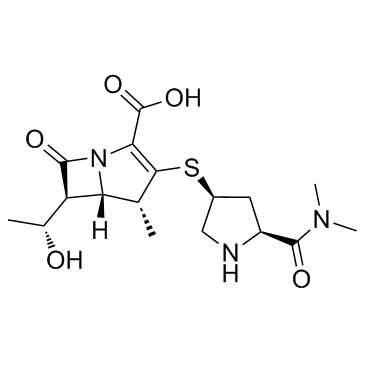
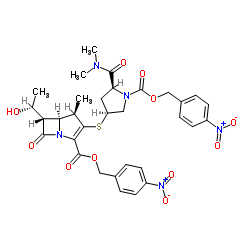
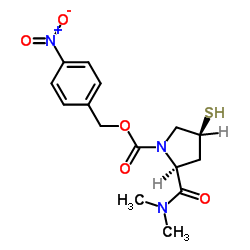
![4-nitrobenzyl (4R,5S,6S)-3-[[(3S,5S)-5-(dimethylcarbamoyl)-3-pyrrolidinyl]thio]-6-[(1R)-1-hydroxy-ethyl]-4-methyl-7-oxo-1-azabicyclo[3.2.0]hept-2-ene-2-carboxylate structure](https://image.chemsrc.com/caspic/370/141818-52-2.png)
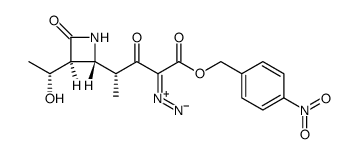
![4-nitrobenzyl (4R,5R,6S)-6-[(1R)-1-hydroxyethyl]-4-methyl-3,7-dioxo-1-azabicyclo[3.2.0]-heptane-2-carboxylate structure](https://image.chemsrc.com/caspic/055/104873-15-6.png)
